Acute stress impairs hippocampal mossy fiber-CA3 long-term potentiation by enhancing cAMP-specific phosphodiesterase 4 activity
- PMID: 20237461
- PMCID: PMC3055459
- DOI: 10.1038/npp.2010.33
Acute stress impairs hippocampal mossy fiber-CA3 long-term potentiation by enhancing cAMP-specific phosphodiesterase 4 activity
Abstract
The mossy fiber synapses onto hippocampal CA3 neurons show unique molecular features and a wide dynamic range of plasticity. Although acute stress has been well recognized to alter bidirectional long-term synaptic plasticity in the hippocampal CA1 region and dentate gyrus, it remains unclear whether the same effect may also occur at the mossy fiber-CA3 synapses. Here, we report that hippocampal slices prepared from adult mice that had experienced an acute unpredictable and inescapable restraint tail-shock stress showed a marked impairment of long-term potentiation (LTP) induced by high-frequency stimulation or adenylyl cyclase activator forskolin. This effect was prevented when animals were submitted to bilateral adrenalectomy or given the glucocorticoid receptor antagonist RU38486 before experiencing stress. In contrast, stress has no effect on synaptic potentiation induced by the non-hydrolysable and membrane-permeable cyclic adenosine 5'-monophosphate (cAMP) analog Sp-8-bromo-cAMPS. No obvious differences were observed between control and stressed mice in the basal synaptic transmission, paired-pulse facilitation, or frequency facilitation at the mossy fiber-CA3 synapses. We also found that the inhibitory effect of stress on mossy fiber LTP was obviated by the adenosine A(1) receptor antagonist 8-cyclopentyl-1,3,-dipropylxanthine, the non-specific phosphodiesterase (PDE) inhibitor 3-isobutyl-methylxanthine, and the specific PDE4 inhibitor 4-(3-butoxy-4-methoxyphenyl)methyl-2-imidazolidone. In addition, stress induces a sustained and profound increase in cAMP-specific PDE4 activity. These results suggest that the inhibition of mossy fiber LTP by acute stress treatment seems originating from a corticosterone-induced sustained increase in the PDE4 activity to accelerate the metabolism of cAMP to adenosine, in turn triggering an adenosine A(1) receptor-mediated impairment of transmitter release machinery.
Figures
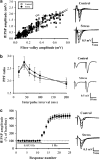
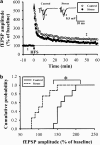

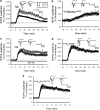
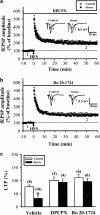

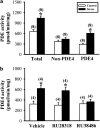
Similar articles
-
Masking of forskolin-induced long-term potentiation by adenosine accumulation in area CA1 of the rat hippocampus.Neuroscience. 1999 Jan;88(1):69-78. doi: 10.1016/s0306-4522(98)00200-0. Neuroscience. 1999. PMID: 10051190
-
Late phase of long-term potentiation in the mossy fiber-CA3 hippocampal pathway is critically dependent on metalloproteinases activity.Hippocampus. 2010 Aug;20(8):917-21. doi: 10.1002/hipo.20787. Hippocampus. 2010. PMID: 20572195
-
Prior short-term synaptic disinhibition facilitates long-term potentiation and suppresses long-term depression at CA1 hippocampal synapses.Eur J Neurosci. 1999 Nov;11(11):4059-69. doi: 10.1046/j.1460-9568.1999.00819.x. Eur J Neurosci. 1999. PMID: 10583494
-
Sequential activation of soluble guanylate cyclase, protein kinase G and cGMP-degrading phosphodiesterase is necessary for proper induction of long-term potentiation in CA1 of hippocampus. Alterations in hyperammonemia.Neurochem Int. 2004 Nov;45(6):895-901. doi: 10.1016/j.neuint.2004.03.020. Neurochem Int. 2004. PMID: 15312984 Review.
-
A peculiar form of potentiation in mossy fiber synapses.Epilepsy Res Suppl. 1992;7:151-7. Epilepsy Res Suppl. 1992. PMID: 1334660 Review.
Cited by
-
A novel PDE9 inhibitor WYQ-C36D ameliorates corticosterone-induced neurotoxicity and depression-like behaviors by cGMP-CREB-related signaling.CNS Neurosci Ther. 2018 Oct;24(10):889-896. doi: 10.1111/cns.12864. Epub 2018 May 2. CNS Neurosci Ther. 2018. PMID: 29722134 Free PMC article.
-
Impairment of adenylyl cyclase-mediated glutamatergic synaptic plasticity in the periaqueductal grey in a rat model of neuropathic pain.J Physiol. 2015 Jul 1;593(13):2955-73. doi: 10.1113/JP270384. Epub 2015 May 14. J Physiol. 2015. PMID: 25868084 Free PMC article.
-
Dynamic regulation of NMDAR function in the adult brain by the stress hormone corticosterone.Front Cell Neurosci. 2012 Mar 6;6:9. doi: 10.3389/fncel.2012.00009. eCollection 2012. Front Cell Neurosci. 2012. PMID: 22408607 Free PMC article.
-
Traumatic Brain Injury Upregulates Phosphodiesterase Expression in the Hippocampus.Front Syst Neurosci. 2016 Feb 5;10:5. doi: 10.3389/fnsys.2016.00005. eCollection 2016. Front Syst Neurosci. 2016. PMID: 26903822 Free PMC article.
-
Sleep and protein synthesis-dependent synaptic plasticity: impacts of sleep loss and stress.Front Behav Neurosci. 2014 Jan 21;7:224. doi: 10.3389/fnbeh.2013.00224. eCollection 2013. Front Behav Neurosci. 2014. PMID: 24478645 Free PMC article. Review.
References
-
- Alzheimer C, Röhrenbeck J, ten Bruggencate G. Adenosine depresses induction of LTP at the mossy fiber-CA3 synapse in vitro. Brain Res. 1991;543:163–165. - PubMed
-
- Bains JS, Longacher JM, Staley KJ. Reciprocal interactions between CA3 network activity and strength of recurrent collateral synapses. Nat Neurosci. 1999;2:720–726. - PubMed
-
- Bruns RF, Lu GH, Pugsley TA. Characterization of the A2 adenosine receptor labeled by [3H]NECA in rat striatal membranes. Mol Pharmacol. 1986;29:331–346. - PubMed
Publication types
MeSH terms
Substances
LinkOut - more resources
Full Text Sources
Other Literature Sources
Medical
Miscellaneous

